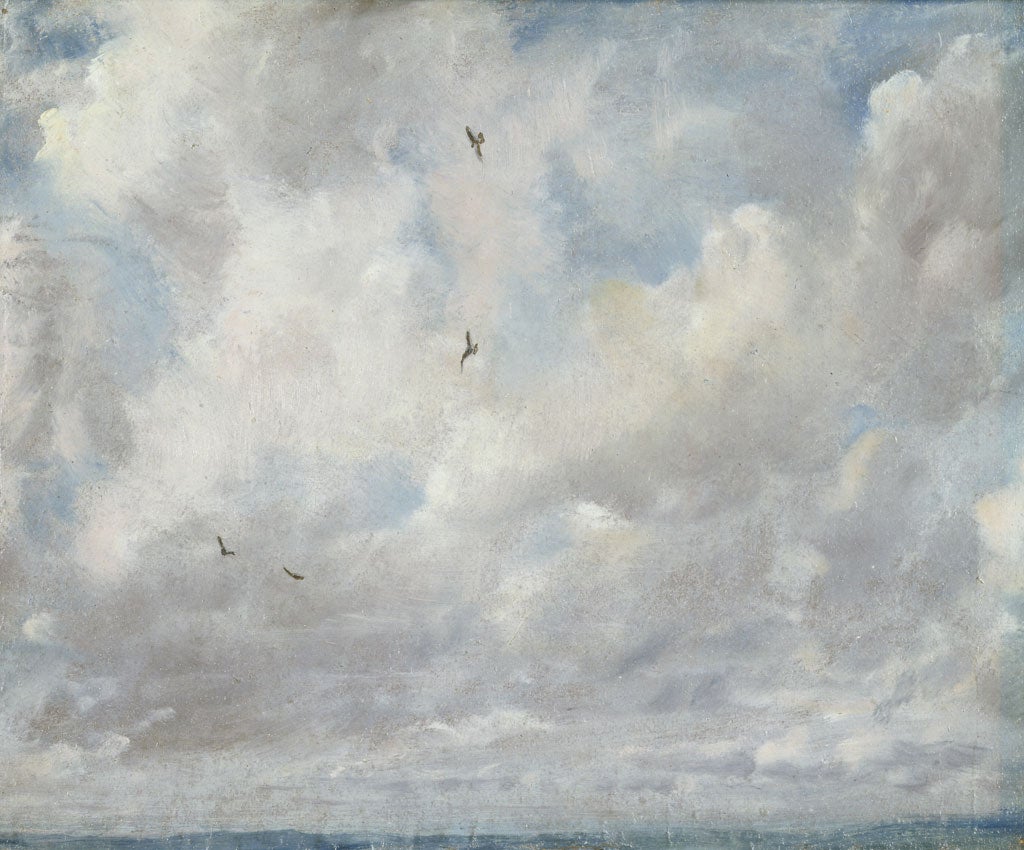Great Works: Cloud Study, 1821 (24.8cm x 30.2cm), John Constable
Yale Center for British Art

Your support helps us to tell the story
From reproductive rights to climate change to Big Tech, The Independent is on the ground when the story is developing. Whether it's investigating the financials of Elon Musk's pro-Trump PAC or producing our latest documentary, 'The A Word', which shines a light on the American women fighting for reproductive rights, we know how important it is to parse out the facts from the messaging.
At such a critical moment in US history, we need reporters on the ground. Your donation allows us to keep sending journalists to speak to both sides of the story.
The Independent is trusted by Americans across the entire political spectrum. And unlike many other quality news outlets, we choose not to lock Americans out of our reporting and analysis with paywalls. We believe quality journalism should be available to everyone, paid for by those who can afford it.
Your support makes all the difference.With John Constable, we often have to be a little wary of the set-piece ventures, those moments when he is evidently painting to impress. Some of his so called "six-footers" of the 1820s are such works. He seems to be measuring out his experiences by the ladleful, balancing this hedge against that gate, this band of soaring sky against that steeple. All feels too exquisitely composed and even controlled.
By contrast, he is often at his best, and most seemingly and passionately committed to the work in hand, when he is doing something almost for its own sake, and the subject itself feels to be scarcely much of a subject at all – that is how we often think about his cloud studies over Hampstead Heath, for example, that they are tiny notations, as much movements towards as finished works. And yet these studies are often so exquisite precisely because they look snatched, impromptu, unpremeditated, uncalculated to please the potential purchaser. The fact is that Constable seems to be forgetting himself even as he is painting them, so thoroughly absorbed is he into the spectacle.
This small, oil-on-paper cloud study of 1821, painted in the same year as The Hay Wain, is such a painting. It has a brilliant, carefully careless zestfulness about it. It is intemperate, almost rushing. It swings and blows and blusters in all directions at once. Constable's thrilled eye seems to suggest that the world has been reborn in a mood of rapture. The clouds are in state of constant movement, both receding from us and surging forward towards us, ever playfully refashioning themselves as they scud along. If we looked at an image of this painting, we would have no idea of its size. It could be enormous. Its subject matter – the heavens yawning wide – makes it feel enormous. In fact, it is less than one-foot square; its overreaching subject matter is contained, confined, within the narrowest of compasses. The painting is both light and insubstantial with its play of ever fleeting colours, and also robustly present – see how the greys and the yellows and the pinks seem to thicken it out, giving it body and substance, a kind of forcefulness and feistiness. Like a child staring up, we almost will these clouds, these sometimes lumpish and occasionally breathtakingly graceful maelstroms, to become recognisable shapes. There is a being up there somewhere, we idly speculate, among, behind, within all that reeling limitlessness, even if he is a creature of our fancy.
If the clouds are carelessly self-renewing, self-refashioning, this tiny handful of birds ranging around the skyways is quite the opposite. They are painted with a great attention to character and very particular movement. One appears to hang, idling, in the air, wind-buoyed; another makes a sudden diving, turning curve; yet another seems to float, almost effortlessly. The presence of these birds helps to give the painting some sense of a foreground and a background. We seem to be dealing – it is all a pretty illusion, of course – with near calculable depths of space. The narrow strip of landscape at the painting's foot also roots it in a particular, though fairly indeterminate (not so to Constable himself, of course) location. This is fairly unusual for the cloud studies of these years, which often consist of nothing but wheeling, vertigo-inducing voids of sky that seem to exist everywhere and nowhere all at once. The rhapsodic mood of it all, as the critic Michael Rosenthal once pointed out, puts us in mind of a moment in the sixth book of the Prelude, the long verse autobiography written by Constable's exact contemporary, William Wordsworth. Here is what Wordsworth wrote:
The unfettered clouds and regions of the Heavens,
Tumult and peace, the darkness and the light –
Were all like workings of one mind, the features
Of the same face, blossoms upon one tree:
Characters of the great Apocalypse,
The types and symbols of Eternity...
Yes, the spirit of Constable is in that description somewhere – but only to a point. We also feel that Constable wouldn't necessarily have welcomed the burden of this species of quasi-religiosity. It over-interprets the scene, we feel. By contrast, this is how Constable himself described this painting, on its verso, so humbly, so matter-of-factly: "Sep.r 28. 1821/Noon – looking. North. West./ Windy from the S.W./large bright clouds flying rather fast/very stormy night followed".
ABOUT THE ARTIST
John Constable (1776-1837) was hugely influential in the development of Realism in general and English landscape painting in particular at the turn of the 19th century. It is against the soporific backdrop of some of his most widely disseminated images – 'Salisbury Cathedral from the Bishop's Grounds', 'The Hay Wain' – that the fantasy of the benignly beauteous character of rural England has been gently nurtured.
Join our commenting forum
Join thought-provoking conversations, follow other Independent readers and see their replies
Comments